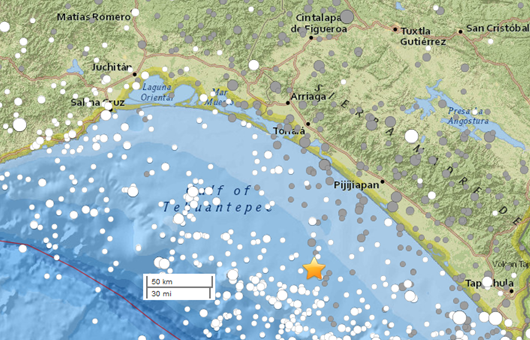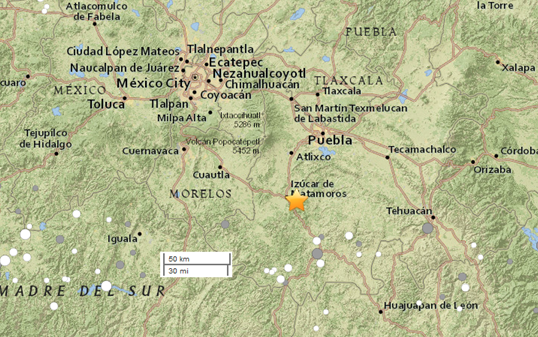Two major earthquakes struck Mexico, a seismically active country, within two weeks in September 2017. The first and strongest earthquake occurred off the southern Pacific coast of Mexico and the second earthquake occurred 11 days later in central Mexico. The second earthquake also triggered the eruption of the Popocatépetl volcano located about 72 km (45 mi) southeast of Mexico City. Whether the two earthquakes were related has yet to be determined, with expert seismologists giving conflicting views. However, the possible relationship between them will be an active area of research going forward. See also: Earthquake; Pacific Ocean; Seismology
On September 8, 2017 at 11:49 p.m. local time, a magnitude 8.1 earthquake struck approximately 70 km (44 mi) off the coast of Chiapas, Mexico. This was the strongest earthquake worldwide, since the magnitude 8.3 Chile earthquake in 2015. The earthquake occurred as the result of normal, intraplate faulting [69.7 km (43.3 mi) in depth] of the subducting Cocos plate, according to the United States Geological Survey (USGS). The Pacific Tsunami Warning Center reported tsunami waves 1 meter (3.3 feet) in height along the coast. Early reports from the Mexican states of Chiapas, Oaxaca, and Tabaco said that 98 people were killed and over 40,000 homes were destroyed. See also: Fault and fault structures; Subduction zones; Tsunami; September 2015 Chile earthquake; Volcano

On September 19, 2017 at 1:15 p.m. local time, a magnitude 7.1 earthquake struck in the Mexican state of Puebla approximately 130 km (80 mi) southeast of Mexico City, the capital of Mexico. The earthquake occurred as the result of normal, intraplate faulting [51 km (32 mi) in depth] of the Cocos plate, according to the USGS. Because much of Mexico City is built on the soft soil of an ancient lakebed, which slows down and amplifies seismic waves, the shaking effects of an earthquake there are more damaging. One day following the quake, more than 200 people were reported killed in the region surrounding the epicenter, along with extensive damage to buildings and other infrastructure. Although the number of deaths and building damage reports are expected to increase, Mexico’s earthquake early warning system would have given some residents up to a minute to escape vulnerable buildings. In addition, earthquake-resistant construction prevented the collapse of many newer and taller buildings. See also: Earthquake early warning; Earthquake engineering






